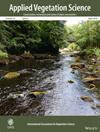Grassland Changes in the Eastern Alps Over Four Decades: Unveiling Patterns Along an Elevation Gradient
Abstract
Aims
Alpine valleys have faced escalating global changes in recent decades such as a decline of traditional management and rural expansion. Grasslands are likely the type of vegetation most affected by these transformations. This study investigates the multifaceted changes in plant diversity over the past four decades in a major valley of the Italian Eastern Alps and examines whether changes occurred uniformly across different elevations.
Location
Valsugana Valley, Eastern Alps, Italy.
Methods
In 2022, we resurveyed 115 vegetation plots (including vascular plants, mosses, and lichens) originally sampled in 1986–1988. Plots were collected in grasslands and span along an elevation gradient of 2000 m. At each time period, we automatically classified these plots using the EUNIS expert system of habitats. We analysed the variation over time in species richness, species diversity, beta diversity (turnover and nestedness), and relative proportion of life form, woodiness, and neophyte species along an elevation gradient, subdivided in low-, middle-, and high-elevation belts. Lastly, we quantified the number of gained, winning, stable, losing, and lost species.
Results
We found differences in the classification of EUNIS habitats and elevation-dependent changes in community diversity and composition. Many grassland types were transformed into other grassland types or into forests and man-made habitats. Species richness varied along the elevation gradient over time, being constant at lower elevations but markedly increasing at high elevations. Temporal turnover dominated across elevations, especially at lower sites, while nestedness components increased towards high elevations. Neophytes increased and hemicryptophytes decreased in the low-elevation belt, while therophytes and geophytes increased at low- and high-elevation belts. In the middle-elevation belt, many dry grassland species were replaced by nitrophilous and woody species. High-elevation witnessed species replacement with the loss of mountain species and the increase of therophyte and geophyte species.
Conclusions
Grasslands of Valsugana valley have undergone substantial changes over four decades. Different processes likely acted across the elevation gradient. Nonetheless the driver, impoverishment of semi-natural grassland species was observed over time across elevations. Understanding these changes in vegetation is essential for a comprehensive evaluation of ecological variations over time. Conservation management strategies should be tailored to address biodiversity changes at varying elevations to counteract the negative trends of plant diversity loss and the ongoing habitat transformation of grasslands in the Alps.


 求助内容:
求助内容: 应助结果提醒方式:
应助结果提醒方式:


